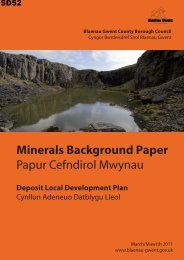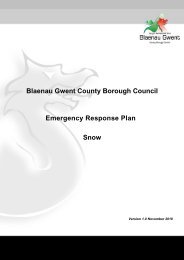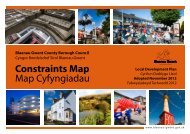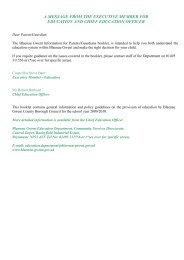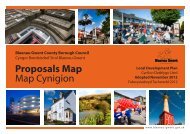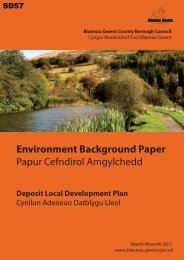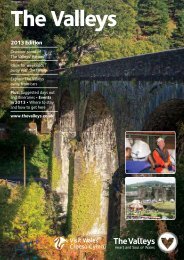Planning Policy Wales - Brecon Beacons National Park
Planning Policy Wales - Brecon Beacons National Park
Planning Policy Wales - Brecon Beacons National Park
Create successful ePaper yourself
Turn your PDF publications into a flip-book with our unique Google optimized e-Paper software.
even at times of flood, to result in no net loss of floodplain storage, to not impede water flows<br />
and to not increase flood risk elsewhere. Local planning authorities should recognise that it will<br />
be inappropriate to locate certain types of development such as schools, hospitals, residential<br />
development and emergency services within some areas defined as being of high flood hazard. In<br />
such areas, local planning authorities should ensure that only appropriate land allocations are made<br />
during the preparation of development plans 2 .<br />
13.3.3 The Environment Agency has a key role in advising and helping planning authorities and<br />
developers to understand the causes and effects of flooding within a river catchment and early<br />
consultation with them is recommended 3 . Further useful information is available in Catchment Flood<br />
Management Plans 4 and River Basin Management Plans 5 .<br />
13.4 Development control and flood risk<br />
13.4.1 Development proposals in areas defined as being of high flood hazard should only be<br />
considered where:<br />
• new development can be justified in that location, even though it is likely to be at risk from<br />
flooding; and<br />
• the development proposal would not result in the intensification of existing development which<br />
may itself be at risk; and<br />
• new development would not increase the potential adverse impacts of a flood event (and see<br />
12.4.1 and 12.4.2).<br />
13.4.2 In determining applications for development, local planning authorities should work closely<br />
with the Environment Agency, drainage bodies, sewerage undertakers, prospective developers<br />
and other relevant authorities to ensure that surface water run-off is to be controlled as near to the<br />
source as possible by the use of sustainable urban drainage systems 6 7 . They should also ensure that<br />
development does not:<br />
• increase the risk of flooding elsewhere by loss of flood storage or flood flow route; or<br />
• increase the problem of surface water run-off (and see 12.4.1 and 12.4.2).<br />
13.4.3 It is essential that the Environment Agency’s advice is obtained and given due weight as<br />
a material consideration by planning authorities in determining individual planning applications.<br />
<strong>Planning</strong> authorities must have good reasons for not following the advice of the Environment Agency,<br />
and these should be reported to the Environment Agency prior to planning permission being<br />
granted, enabling them to consider submitting further representations. Where detailed information<br />
in respect of flood risk is not available, local planning authorities should require developers to carry<br />
out detailed technical investigations to evaluate the extent of the risk.<br />
13.4.4 <strong>Planning</strong> authorities should bear in mind that the Environment Agency will not automatically<br />
provide or extend a flood warning service. The Environment Agency has demanding targets to<br />
meet and any increase in the number of new properties requiring a flood warning service will make<br />
184<br />
<strong>Planning</strong> <strong>Policy</strong> <strong>Wales</strong> Edition 3 - July 2010 - Chapter 13 Minimising and Managing Environmental<br />
Risks and Pollution


